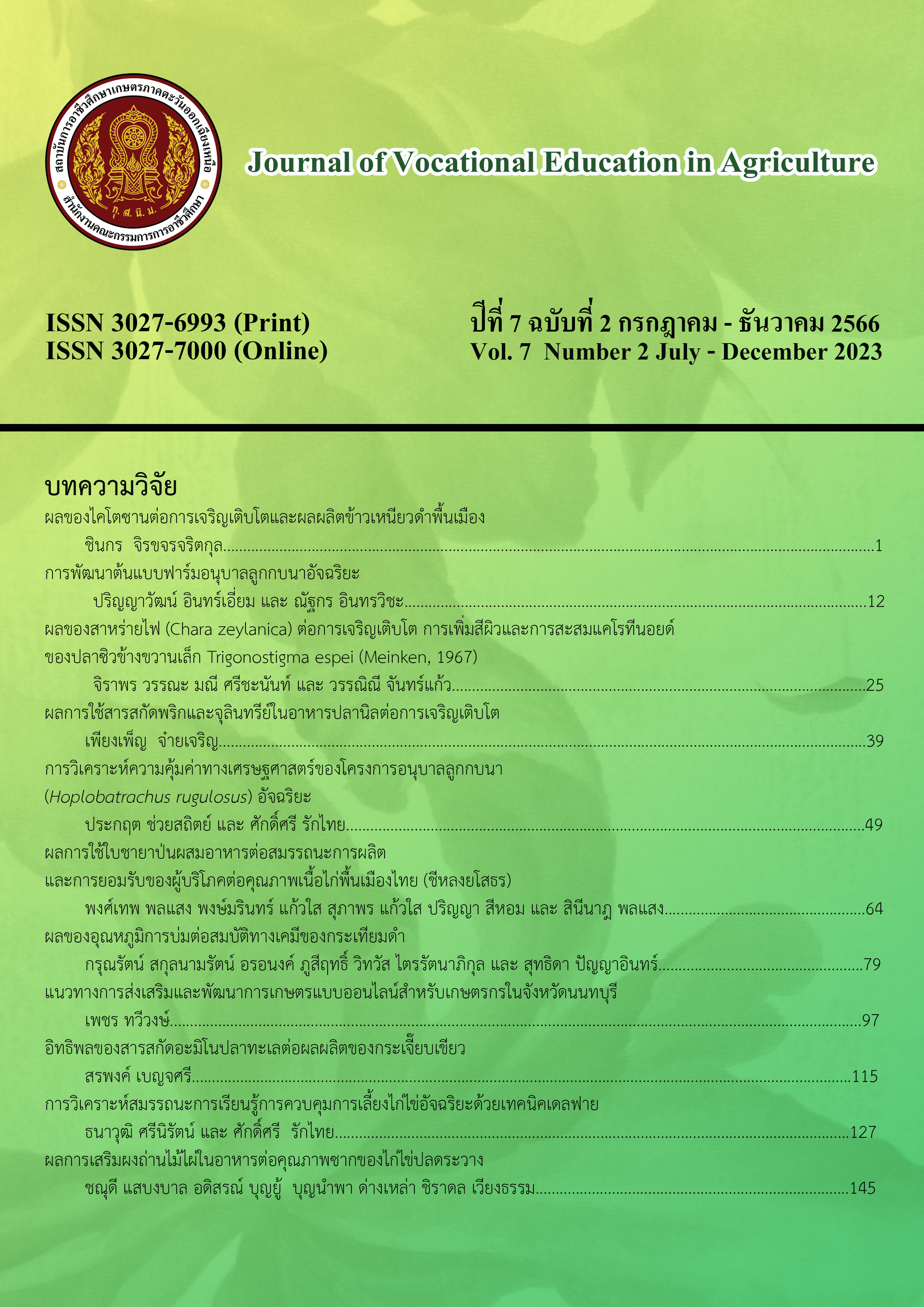ผลการใช้ใบชายาป่นผสมอาหารต่อสมรรถนะการผลิตและ การยอมรับของผู้บริโภคต่อคุณภาพเนื้อไก่พื้นเมืองไทย (ชีหลงยโสธร)
Main Article Content
บทคัดย่อ
ไก่พื้นเมืองไทย (ชีหลงยโสธร) มีความทนทานต่อสภาพแวดล้อมและสามารถกินอาหารที่มีในท้องถิ่น เช่น ใบชายา ซึ่งมีคุณค่าทางโภชนะที่คาดว่าจะส่งผลดีต่อการเลี้ยงไก่ จึงทำการศึกษาผลของการใช้ใบชายาป่นต่อสมรรถนะการผลิตและการยอมรับของผู้บริโภคต่อคุณภาพเนื้อไก่พื้นเมืองไทย (ชีหลงยโสธร) แบ่งเป็นการทดลองที่ 1 ใช้ใบชายาป่นที่ระดับร้อยละ 0, 5, 10 และ 15 ผสมอาหารเลี้ยงไก่ใช้ลูกไก่คละเพศอายุ 1 วันจำนวน 160 ตัว จัดแบ่งเข้าทดลองโดยใช้แผนการทดลองแบบสุ่มสมบูรณ์ จำนวน 4 ซ้ำๆ ละ 10 ตัว เก็บข้อมูลสมรรถนะการผลิตไก่จนถึงอายุ 12 สัปดาห์ และการทดลองที่ 2 ประเมินคุณภาพเนื้อไก่ด้วยการชิมตามวิธี Panel’s test ใช้ผู้ชิมจำนวน 16 คนใช้แผนการทดลองแบบสมดุลโดยใช้การสุ่มไม่สมบูรณ์ในบล็อกนำข้อมูลมาวิเคราะห์หาความแปรปรวนเพื่อตรวจสอบค่า P<.05 พบว่าปริมาณอาหารที่กิน จำนวนไก่คงเหลือ ต้นทุนค่าลูกไก่ ความนุ่ม ความเหนียว ความหอม ความละเอียดเส้นใยกล้ามเนื้อและความน่าจะกินไม่มีความแตกต่างกันทางสถิติ (P>.05) ส่วนการใช้ใบชายาป่นร้อยละ 15ในสูตรอาหารส่งผลให้น้ำหนักที่เพิ่มขึ้นอัตราการเปลี่ยนอาหารเป็นเนื้อต้นทุนค่าอาหารต้นทุนการเลี้ยงไก่ ราคาขายไก่
กำไร/ขาดทุนน้ำหนักซากสีเนื้อไก่ ความชุ่มฉ่ำ รสชาติ (P<.01) เปอร์เซ็นต์ซากและการยอมรับของผู้บริโภค (P<.05) ดีที่สุด ดังนั้นการใช้ใบชายาป่นผสมอาหารเลี้ยงไก่พื้นเมืองไทย (ชีหลงยโสธร) ร้อยละ 15 ทำให้ไก่มีสมรรถนะการเจริญเติบโต ให้ผลตอบแทนและผู้บริโภคยอมรับคุณภาพเนื้อไก่มากที่สุด โดยมีต้นทุนราคาอาหารต่ำที่สุด
Article Details

อนุญาตภายใต้เงื่อนไข Creative Commons Attribution-NonCommercial-NoDerivatives 4.0 International License.
เนื้อหาและข้อมูลในบทความที่ลงตีพิมพ์ใน Journal of Vocational Education in Agriculture ถือเป็นข้อคิดเห็นและความรับผิดชอบของผู้เขียนบทความโดยตรง ซึ่งกองบรรณาธิการวารสารไม่จำเป็นต้องเห็นด้วยหรือร่วมรับผิดชอบใดๆ
บทความ ข้อมูล เนื้อหา ฯลฯ ที่ได้รับการตีพิมพ์ใน Journal of Vocational Education in Agriculture ถือเป็นลิขสิทธิ์ของJournal of Vocational Education in Agriculture หากบุคคลหรือหน่วยงานใดต้องการนำทั้งหมดหรือส่วนหนึ่งส่วนใดไปเผยแพร่ต่อหรือเพื่อกระทำการใดๆ จะต้องได้รับอนุญาตเป็นลายลักษณ์อักษรจาก Journal of Vocational Education in Agriculture ก่อนเท่านั้น
เอกสารอ้างอิง
Tisdell, C. (2003). Socioeconomic causes of loss of animal genetic diversity: analysis and assessment. Ecological Economics, 45(3), 365-376.
Chainok, K. (2019). Chaya: delicious tree. Bangkok: Mahidol University. (in Thai)
Sricho, S. (2022). Chaya: MSG tree for health lovers. Available from https://acuisineth.com/ food-story/chaya-Spinash. Accessed date: 1 March 2022. (in Thai)
Kumar, A., et al. (2010). In vitro nutritional evaluation of chaya (Cnidoscolus aconitifolius) for use as livestock feed. Indian journal of animal sciences, 80(10), 1008-1010.
Kumar, A., et al. (2010). Amino acid profile of chaya and its protein degradation rates in dairy cattle. Indian journal of animal sciences, 80(8), 737-740.
Sarmiento-Franco, L., et al. (2002). Performance of broilers fed on diets containing different amounts of chaya (Cnidoscolus aconitifolius) leaf meal. Tropical Animal Health Production, 34(3), 257-269.
Sarmiento-Franco, L., et al. (2003). The effect of chaya (Cnidoscolus aconitifolius) leaf meal and of exogenous enzymes on amino acid digestibility in broilers. British Poultry Science, 44(3), 458-463.
Polsang, P., et al. (2022). Effects of chaya (Cnidoscolus aconitifolius) leaf mixed with food during the brooding period of Thai native chicken (Chee-Long Yasothon) (Research reports). Yasothon: Yasothon College of Agriculture and Technology.
SAS Institute. (2018). SAS/STAT user’s guide SAS University Edition 9.4. Cary, NC: SAS Institute Inc.
Meilgaard, C., et al. (2007). Sensory Evaluation Techniques. Baca Raton: CRC Press.
Brody, A. L. & Lord, J. B. (2007). Developing New Food Products for a Changing Marketplace. 2nd ed. Baca Raton: CRC Press.
Health. (2020). Chaiya vegetables. Available from https://mthai.com/health/45002.html. Accessed date: 25 December 2020. (in Thai)
Kumar, A., et al. (2010). Effect of replacement of Concentrate mixture with chaya (Cnidoscolus aconitifolius) fodder meal on feed intake and digestibility of nutrients in growing goats. Indian Journal of Animal Sciences, 80(9), 910-912.

